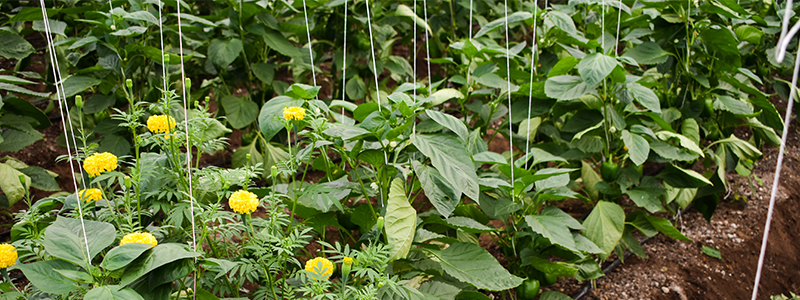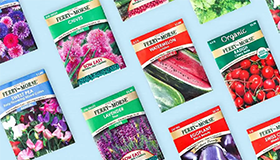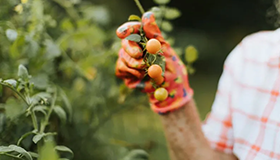Companion Planting: Breaking down the concept of companion planting and identifying which plants benefit others and why
Ferry-Morse Home Gardening Blog | 2024

Marigolds growing amongst pepper plants to ward off garden pests.
Companion planting—It sounds great! But what in the blooming meadows is it?
Companion planting is the practice of establishing plants in a garden to benefit each other mutually, although not necessarily equally.
The only thing is, it also depends on who you ask, its interpretation being akin to holding a tilt card at various angles and seeing a different picture each time.
Well, let’s start tilting to see how it works.
Why do gardeners use companion planting?
Many gardeners install varieties strategically to improve their plants’ growth and productivity.
The “Three Sisters” method of planting pole beans, corn, and squash together is a famous example that works like this:
- Corn plants support climbing beans.
- Beans supply nitrogen to the corn, a heavy feeder.
- Bean leaves camouflage the corn from the corn earworm moth.
- Squash leaves shade the soil, lessening evaporation and blocking sunlight from weeds.
Gardeners have used this method for centuries to provide nutrients, moisture, trellising, weed suppression, and pest control to benefit the trio of plants.
Another way gardeners use companion planting is to derive aesthetic benefits. For example, tucking daffodil bulbs under a lantana bush provides early spring color that fades away as lantana starts blooming later in the season.
It seems pretty cool, right? Let’s learn more.
Companion planting charts
Companion planting charts might be available through your local agricultural extension office. Let’s look at a few examples concerning popular garden plants.

Chard, dahlias, cosmos and more growing together in a flourishing garden.
Tomatoes
Tomatoes are a desirable crop that can produce a lot of fruit in a relatively small space. Lamentably, they are also prone to several diseases and insect pest infestations. Fortunately, lots of plant friends are available to help!
Scented marigolds and tomatoes love being neighbors! Marigolds protect tomatoes from root-knot nematodes and produce a strong scent that repels whiteflies.
Furthermore, marigolds benefit from being near a crop that thrives in similar growing conditions, receiving care right along with its high-maintenance tomato plant neighbors.
Other plants that help tomatoes include the following:
- Basil’s aroma repels thrips and hornworms, while its white flower spikes beckon pollinators.
- Borage entices pollinators like bees and beneficial predatory wasps.
- Chives improve the flavor of tomatoes while repelling green flies and aphids.
- Garlic’s pungent scent discourages aphids and other bothersome pests.
- Parsley repels beetles and lures beneficial hoverflies, its seeds attracting the parasitic wasps that control hornworms.
On the other side of the leaf, tomatoes reportedly help asparagus by deterring asparagus beetles and, when near cucumbers, derive cultural advantages. See how it works? Let’s discuss a few more.
Peppers
Even the spiciness of peppers can’t keep pests away, as they are susceptible to aphids, cutworms, flea beetles, and pepper weevils.
Harnessing the aromatic power of herbs like basil, mint, marjoram, oregano, and tansy helps shoo these pests away while attracting beneficial pollinators.
Culturally, peppers grow well with carrots, marjoram, okra, onions, and tomatoes.
Strawberries
Garden strawberries taste oh-so-sweet, but the neverending battle with pests, pathogens, and nematodes might leave you feeling bitter. And they are super-sensitive to soil and water conditions too.
Trusted sources recommend pairing them with beans, borage, lettuce, onion, and spinach, making sense because they thrive in similar growing conditions. And the best part is that beans contribute nitrogen to the soil, available to be taken up by the strawberry plants.
If interested, take a little time to learn more about companion planting for strawberries.

Close-up of maturing strawberries.
Onions
Onions are generous neighbors in companion planting arrangements.
Plant onions near various plants to ward off aphids, borers, mites, slugs, cutworms, and maggots. Varieties benefitting from proximity to onions include beets, cabbage, carrot, chard, lettuce, strawberry, and tomatoes.
And even onions need friends that give back. So, count on chamomile or savory to improve their growth and flavor.
But wait, there’s more!
Other things to see while tilting the companion-planting card include diversification, hydro-zoning, native plantings, shade gardening, and succession planting. Let’s look at each one.
Diversification
When too many plants of the same variety exist in a landscape, pests and diseases targeting that variety will adore having a large patch of their favorite plant to destroy.
Increasing the diversity of a landscape works wonders in preventing this disaster. Try to have no more than 10 percent of a cultivar and less than 30 percent of plants of the same family.
This diversification mixes things up enough to prevent pathogens from spreading mercilessly through a monoculture of plants.
Hydro-zoning
Hydro-zoning is grouping plants according to their similar water needs, classified as natural rainfall, occasional watering, and regular watering.
Planting varieties of similar watering needs as companions can meet their moisture requirements simultaneously due to proximity, like pairing moisture-loving strawberries and spinach.
Native plants
Native plants provide habitat for beneficial organisms, supporting the enemies of many common pests, making them excellent companion plants in your garden! Nuff said!
Shade gardening
Shade under a tree cannot support turfgrass, making it the perfect spot for you to install shade-loving varieties there to do things like hiding a bare patch of dirt, thereby making it more aesthetically pleasing. Asiatic jasmine, liriope, and periwinkle are varieties that perform and look great under trees.
Succession planting
Vegetable companion planting can focus on the avoidance of mineral depletion through rotating crops.

Succession planting carrot crop.
So what does all this mean?
Companion planting is one of those areas of gardening that mixes folklore, science, and myths. Nevertheless, we know that plants are capable of benefiting each other in many ways.
Some pairings work as expected from a companion planting chart, while others simply don’t, which can be due to many factors ranging from soil type to weather to hardiness. It’s important to remember that companion planting does not replace regular care and maintenance of plants.
Our advice is to take a lighthearted approach to the experimental aspect of companion planting, enabling you to enjoy seeing how different combinations work in your garden. And eventually, you’ll learn how to translate this concept into actual results.
CLICK HERE TO EXPLORE THE REST OF THE FERRY-MORSE GARDENING BLOG -->



